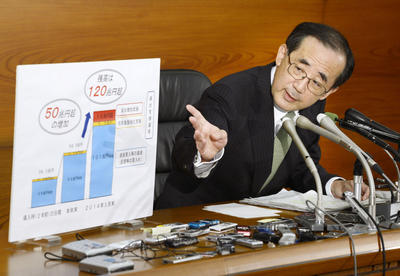In the recent election, the LDP, which won handsomely, argued that the Bank of Japan should take much more aggressive measures to enhance inflation. New Prime Minister Abe has said that the central bank should set an inflation target of 2 per cent, which is OK, but in order to achieve this target, the Bank of Japan may be required to increase quantitative easing and make very large purchases of government bonds.
There are many concerns with this view. First of all, although mild inflation rates of around 2–3 per cent seem to be desirable, theoretical studies have not yet found that mild deflation causes any significant welfare losses. Second, it is not clear whether further quantitative easing or increased government bond purchases by the central bank would spur mild inflation, especially under the zero lower-bound constraint on nominal interest rates.
Both these issues are very important. The first relates to how the target level of inflation should be set. The details can be very complex, but at a basic level the answer depends on one’s own point of view as to how nominal variables such as inflation affects real variables such as GDP. This is a crucial issue beyond the scope of this article.
The second point raises an interesting question for Japanese policymakers: will more aggressive monetary policy, in the form of a direct purchase of government bonds by the central bank, create mild inflation or could it instead lead to hyperinflation? There are two famous macroeconomic views on this subject. The first regards inflation as determined by monetary policy; the second regards it as a product of fiscal settings.
Most readers are probably more familiar with the monetary view. Central banks conduct monetary policy to control the aggregate spending of a nation via nominal interest rates. If nominal interest rates are lower, households and firms can borrow more cheaply and therefore increase spending on, for example, durable goods or investment. Increased spending should result in higher production and production costs — and wages. As a result, the inflation rate increases. In this view, an increase in the supply of money plays almost the same role as a reduction in nominal interest rates by the central bank, unless the nominal interest rate is constrained at the zero lower bound.
On the other hand, the fiscal view states that price levels, and therefore inflation, are determined by fiscal policy. This idea is sometimes called the fiscal theory of the price level (FTPL). According to the FTPL, the price level is determined so that the current real deficit is equal to the present discounted value of real net tax receipts. Otherwise, the government is unable to pay its debts. If you hold a government bond, you do not want to hold it forever. Rational agents will not be so kind as to lend money without hope of the repayment — not even the government is entitled to a free lunch. Given Japan’s high debt–GDP ratio, a period of hyperinflation would be theoretically unsurprising.
The fiscal view of the price level determination is very simple and mathematically compelling, but doubts remain, especially in respect of day-to-day price or wage setting by firms. Aggregate inflation is eventually determined by the price and wage setting by firms. And in setting day-to-day prices, firms would appear to consider monetary, not fiscal conditions.
Still, history shows that hyperinflation occurs in countries with huge government debt. This is basically the reason why independent central banks were created.
So which is the more compelling theory? It is difficult to tell, but if Japanese citizens start to believe that the government is unable to collect enough tax to repay its debt, hyperinflation will become a distinct possibility, according to the FTPL. This is because inflation becomes the only way for the government to honour its obligations. A large direct purchase of government debt by the Bank of Japan could be a turning point in this regard — Japanese citizens might suddenly doubt the country’s fiscal sustainability.
In any case, it is unclear whether the purchase of the government bonds by the central bank would drive mild inflation. If there is a positive relationship it is likely to be non-linear. It is almost impossible to foresee the exact consequences of the bond purchase suggested by the LDP, but hyperinflation is not out of the question. Hyperinflation leads to significant wealth transfer between economic agents and creates a highly uncertain economic environment. Japan must remain fiscally sustainable.
Ippei Fujiwara is Associate Professor of Economics at the Crawford School of Public Policy, Executive Director (acting) at The Australia-Japan Research Centre and Deputy Director at The Centre for Applied Macroeconomic Analysis, The Australian National University.

